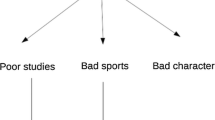Abstract
In this paper, a number of theoretical issues concerning rational beliefs in REBT will be discussed. In particular, a distinction will be made between rational beliefs which appear rational but are only partially rational (called here, partially formed rational beliefs) and rational beliefs that are fully rational (called here, fully formed rational beliefs). Making this distinction has a number of benefits. For example, it helps explain how people transform their partially formed rational beliefs into irrational beliefs and it provides authors of counseling and psychotherapy textbooks with clear, accurate information to pass on to their readership (Dryden 2012). A number of other issues concerning rational beliefs will also be discussed.
Similar content being viewed by others
Notes
I will discuss this concept of transformation later in the paper.
I will discuss the issue of the strength of partially formed rational beliefs and the transformation process later in the paper.
I have included here what I have called the struggle component to combat the view that a discomfort tolerance belief implies that it is or should be easy to tolerate adversity.
I have included this evaluation of “it” (an aspect of the person or an actual inferred event) as part of a fully formed unconditional positive self-rating statement to stress that negative evaluations of such aspects are realistic and healthy.
See note 4.
While escalators go up, the bottom of the escalator is on the same continuum as the top of the escalator.
In its short form: “I must pass my forthcoming exam.”
References
Dryden, W. (2009). Rational emotive behavior therapy: Distinctive features. Hove, East Sussex: Routledge.
Dryden, W. (2012). The ABCs of REBT revisited: Perspectives on conceptualization. New York: Springer.
Ellis, A. (1994). Reason and emotion in psychotherapy: A comprehensive method of treating human disturbance. Revised and updated. New York: Birch Lane Press.
Neenan, M., & Dryden, W. (1999). Rational emotive behaviour therapy: Advances in theory and practice. London: Whurr.
Yankura, J., & Dryden, W. (1990). Doing RET: Albert Ellis in action. New York: Springer.
Author information
Authors and Affiliations
Corresponding author
Additional information
An earlier version of this article was published in: Neenan and Dryden (1999).
Rights and permissions
About this article
Cite this article
Dryden, W. On Rational Beliefs in Rational Emotive Behavior Therapy: A Theoretical Perspective. J Rat-Emo Cognitive-Behav Ther 31, 39–48 (2013). https://doi.org/10.1007/s10942-012-0158-4
Published:
Issue Date:
DOI: https://doi.org/10.1007/s10942-012-0158-4



